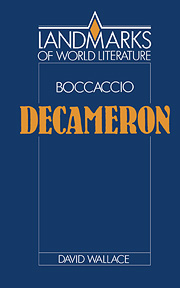Summary
Title and preface
The Decameron opens with a short rubric or explanatory heading in which it declares its own name and its surname or alternative title (‘Prencipe Galeotto’). It then analyses its own contents with mathematical precision: one hundred tales told in ten days by seven young women and three young men. Although this and all later rubrics speak in an impersonal third person, we know (from the autograph manuscript Hamilton 90 in the Berlin Staatsbibliothek) that they were written by Boccaccio himself. The use of those rubrics, which employ an analytic vocabulary drawn from scholastic sources, suggests that Boccaccio (who names himself only as l'autore, the author) wishes his readers to consider the Decameron as a literary opus, not just as a collection of stories. Many medieval authors (Chaucer, for example) choose to address the reader directly with an authorial ‘I’ when speaking of the content and organization of the work in progress. By transferring most of this to third-person rubrics, Boccaccio assumes a more detached authorial positioning (typical, in some respects, of a historical chronicler). He addresses the reader directly at the beginning and end of his opus, and at the beginning of the fourth day, but otherwise remains largely concealed beneath the narrative surface.
It is strange that Boccaccio should bring the Decameron before us as a work with two names, even stranger that these names should compete with rather than gloss or complement one another.
- Type
- Chapter
- Information
- Boccaccio: Decameron , pp. 13 - 107Publisher: Cambridge University PressPrint publication year: 1991

